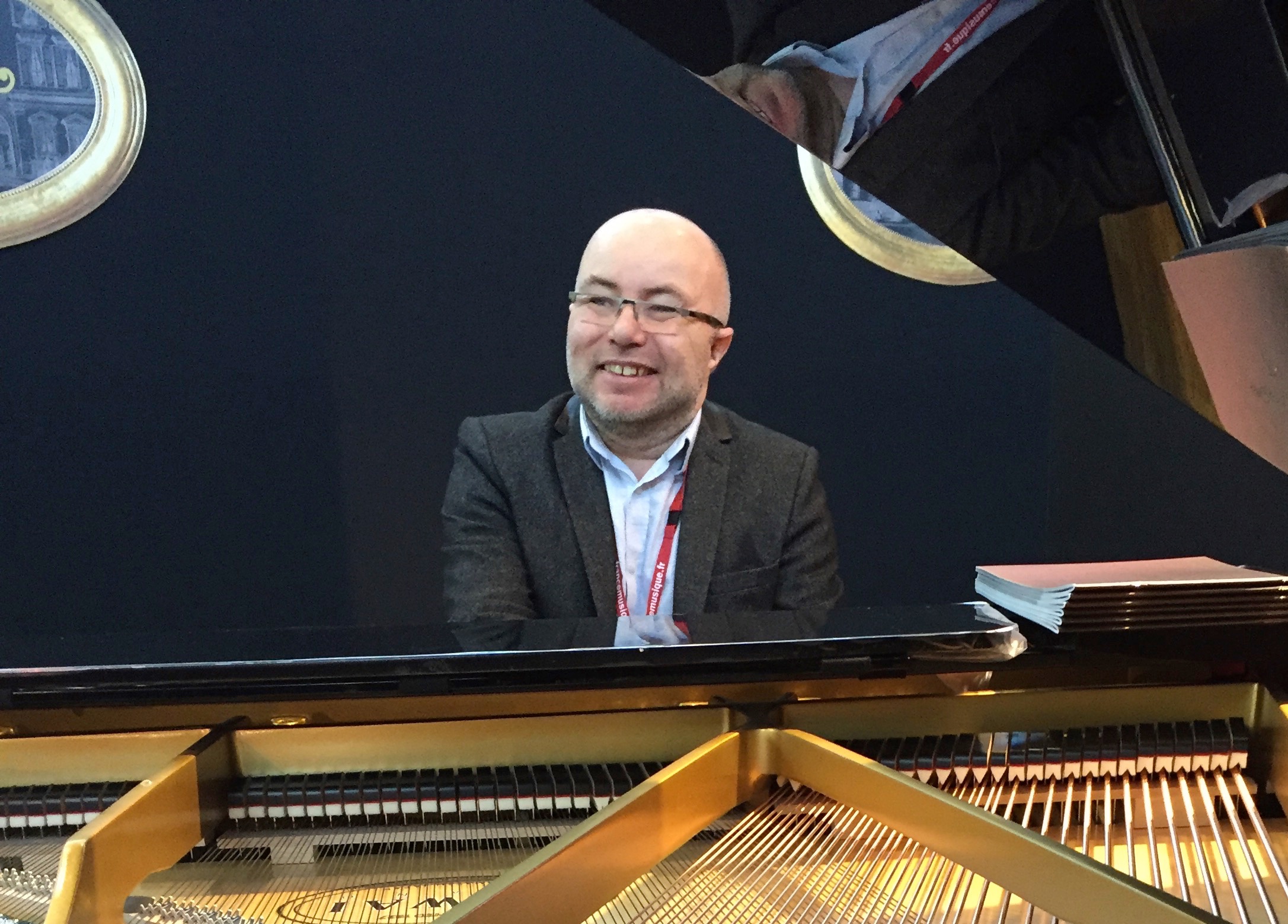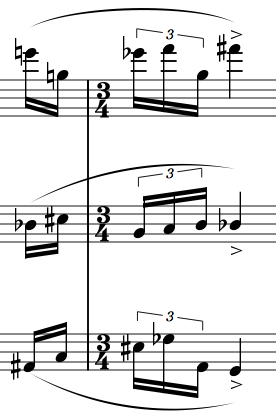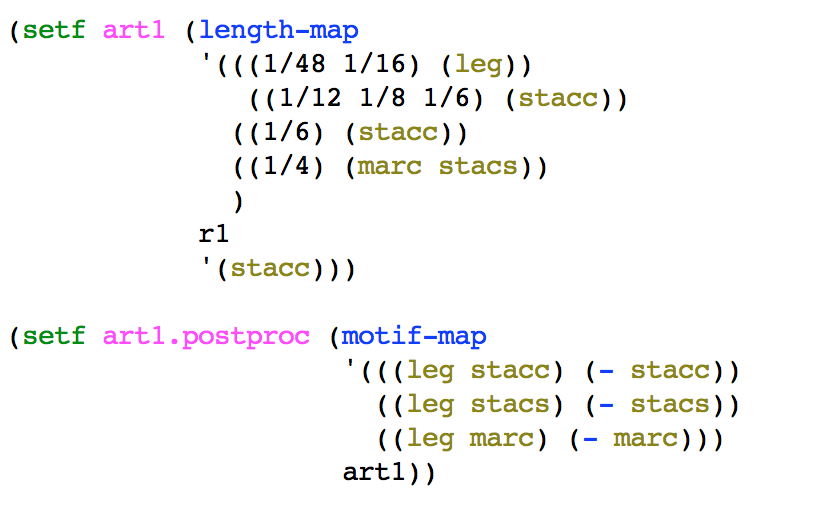-
Posts
1,072 -
Joined
-
Last visited
Content Type
Forums
Events
Store
Video Gallery
Everything posted by Stephane Boussuge
-
Perfect, thank you but would be useful be able to create a pitch-field based on multiple tonality like that: (multiple-expand-tonality :startpitch 'c2 :octaves 3 :tonality '(messiaen-mode1 messiaen-mode3 messiaen-mode4)) but it is already very good like that. Thank you very much. Stéphane
-
Thank you for this very interesting function André. I would love to have more easy way and tools for working with tonality on more than one octave. This one is a very good one and can be very useful when working with pitchfields. About your question, i don't know another way to construct your pitch field based on multiple expand-tonality into One function. May be Janusz ? anyway, i like very much your function. Thanks again for sharing it. SB.
-

audio After The Club for Piano
Stephane Boussuge replied to Stephane Boussuge's topic in Made In Opusmodus
Thanks Deb76 ! S. -
Hi, here's a quiet speed piece playing around the jazz piano ;-) SB.
-

Converting OMN explicit sequence to functions
Stephane Boussuge replied to TomTolleson's topic in OMN Lingo
are you sure you want to put your sequence into functions ? i think you just need to put your sequences into variables and call the variables (eventually with function). Maybe this example could help you: ; put you motive into a variable named m1 (setf m1 '(q b3 e -s b2b2 gs2 as2 a3 g2g2 g2 e2 -e)) ; another motif derived from the first (setf m2 (rnd-order m1 :type :pitch)) ; another one derived with markov-function (setf m3 (gen-markov m1)) ; assembly into one phrase (setf phrase1 (assemble-seq m1 m1 m2 m1 m3 m2 m2 m1)) ; transpose some sections (setf phrase1-transposed (pitch-transpose '(2 4 -6) phrase1 :section '(0 2 4))) -

Converting MIDI or MusicXML to OMN
Stephane Boussuge replied to TomTolleson's topic in Support & Troubleshooting
Hi Tom, you need to open the midi-file into the Opusmodus Player and click in it for give it the focus. After that, go to the File menu (top left in Opusmodus software) and select Export => Midi to score. SB. -

Converting MIDI or MusicXML to OMN
Stephane Boussuge replied to TomTolleson's topic in Support & Troubleshooting
Hi Tom, you can import your file as Midi with the function Midi to score in the File Menu. But for a good importation, your midi need to be very "clean". I generaly obtain very good result from midi conversion to OMN but i prepare carefuly my tracks in logic with no overlap of notes, perfect quantization etc.... Once you midi tracks are clean, import and convert to OMN works very well. I suppose if your tracks come from a score editor, normally the importation into Opusmodus from Midi could be ok. SB. -

Rubrique instruments virtuels avec Opusmodus
Stephane Boussuge replied to Deb76's topic in Suggestions & Ideas
Bonjour Didier, vous pouvez parler de ces sujets dans la rubrique Midi & Setuo mais plutôt en Anglais s'il vous plait afin de pouvoir etre lu de tous. S. -
En effet, je pense qu'il vaut mieux ne pas publier ce script en raison des droits d'auteur. S.
-

score Rock It !! for Piano from Piano suite No.1
Stephane Boussuge replied to Stephane Boussuge's topic in Made In Opusmodus
Merci Didier ! S. -
Le fichier dans mon système se nomme Chord-library, il s'agit sans doute d'un oubli de traduction du titre, je vais remedier à ça. En attendant le voici attaché en pièce jointe re-nommé en "Accords". SB. Accords.rtf
-

score Rock It !! for Piano from Piano suite No.1
Stephane Boussuge replied to Stephane Boussuge's topic in Made In Opusmodus
Thanks Iviklund and Rangarajan. S. -

score Rock It !! for Piano from Piano suite No.1
Stephane Boussuge posted a topic in Made In Opusmodus
Hi, here's a new piece for Piano solo extracted from my piano suite No.1 (work in Progress). The suite is a succession of small piece in different moods. This one is a bit Rock ;-) The score is attached to this post. SB RockIt.opmo -

audio Prelude pour Piano
Stephane Boussuge replied to Stephane Boussuge's topic in Made In Opusmodus
Thanks Robert ! -
Hi, here is a new piece, Prelude pour Piano. Happy listening ! Stéphane.
-
Hi, often when we generate articulation and particularly legato articulation with functions like LENGTH-MAP, the legato slur could finished on marc or stacc notes like that: a possible way for improve this could be to use a post processing of LENGTH-MAP outputs with a MOTIF-MAP function: Attached to this post, a work in progress, Flux for ensemble, as an example of a possible use "in context" of this technique. Have a good day. SB. Flux-Extrait.pdf flux1.mp3 Flux1-02.opmo
-
Hi Ole, This score have nothing new and all the techiques employed here are described in all my other post and scores. It is personal experimentation and not for sharing. Regards Stéphane
-

Optima Pattern Matching Library
Stephane Boussuge replied to Rangarajan's topic in User Extensions Source Code
Very interesting !! Thanks SB. -
Just for the pleasure to share a small track made as a small exercise and experimentation with my favorite software ;-)
-
My way is to compose the piece as much as possible from my score algorithms but it remain frequently some local detail to refine and in that case, in past i used score editor like Sibelius, Notion or Finale but now i'm prefer to stay at the code level and have the possibility to change things at any time with this post processing approach. However, even with this post processing approach, i finish the score into Sibelius but in a much smaller extend than in past and i tend progressively, as my experience and Opusmodus software progress, to do more and more things in Opusmodus and less in score editor. SB.
-
Hi, i have composed a short strings trio as an example of how to use score post processing techniques, ie. change things in a score after the OMN generation by the opmo functions. Score script and mp3 attached to this post. SB. StringsTrio210516g-GM.opmo StringsTrio210516g.mp3
-
i am really sorry but i don't have a video of this performance, i have made it "on the moment" . But the code is very very simple and not very interesting. I attached to this post if you want to have a look. SB. Granite.lisp Test1.opmo
-
Hi, when i compose with opmo, i use not so many different strategies , it is kind of patterns i use and reuse very often. For example, i like to use a vector for describe and drive some aspects of the piece like rhythmical density or instrumental density, harmonic tension/relaxation.... i have some strategies for every aspect like rhythm, harmony, density, dynamics etc...i combine some of them in every composition and i 'm trying to refine them and invent some news from composition to composition. I don't know nothing about UML but if it can describe the thinking of a composer more accuratly, it is pedagogically very interesting ! SB.
-
Recorded LiveCoding improvisation performance. SB.
-

code gen-pitch-line (from vector)
Stephane Boussuge replied to Stephane Boussuge's topic in User Extensions Source Code
Thank you very much Rangarajan for your help. As you can see i am more musician than programmer ;-) Your version is more concise. SB.



